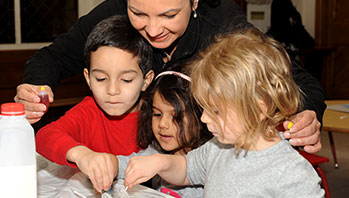- plastic containers with lids (food storage containers, yogurt containers, plastic eggs)
- small objects (dried beans, beads, paper clips, cotton balls, buttons, packing peanuts)
- tubes and hoses (cardboard and plastic)
- different
- same
- sound
MA Standards:
Language/L.PK.MA.6: Use words and phrases acquired through conversations, listening to books read aloud, activities, and play.
MA Draft STE Standards:
Physical Sciences/Matter and Its Interactions/PS1.A: Describe, compare, sort and classify objects based on observable physical characteristics, uses, and whether it is manufactured as part of their classroom play and investigations of the natural and human-made world.
Physical Sciences/Matter and Its Interactions/PS4.A: Investigate different sounds made by different objects and different materials and reason about what is making the sounds. [Cause and Effect]
Head Start Outcomes:
Logic and Reasoning/Reasoning and Problem Solving: Recognizes cause and effect relationships.
Logic and Reasoning/Reasoning and Problem Solving: Classifies, compares, and contrasts objects, events, and experiences.
Approaches to Learning/Initiative and Curiosity: Demonstrates flexibility, imagination, and inventiveness in approaching tasks and activities.
Science Knowledge/Scientific Skills and Method: Uses senses and tools, including technology, to gather information, investigate materials, and observe processes and relationships.
PreK Learning Guidelines:
Mathematics/Patterns and Relations 7: Explore and describe a wide variety of concrete objects by their attributes.
Mathematics/Patterns and Relations 8: Sort, categorize, or classify objects by more than one attribute.
Mathematics/Patterns and Relations 9: Recognize, describe, reproduce, extend, create, and compare repeating patterns of concrete materials.
Science and Technology/Living Things and Their Environment 15: Use their senses of sight, hearing, touch, smell, and taste to explore their environment using sensory vocabulary.
Small Group: Shaker Match

© Commonwealth of Massachusetts, Department of Early Education and Care (Jennifer Waddell photographer). All rights reserved.
STEM Key Concepts: Sounds have a source; Different objects make different sounds; Sounds vary in three ways: volume, pitch, and timbre
ELA Focus Skills: Speaking and Listening, Vocabulary
Join small groups at the Science and Math Center. Have children focus on making pairs of shakers.
Ask children to explain what sound clues helped them guess the objects inside the shakers during the “Shaker Match” activity. Ask, Which objects make the same sounds? Which objects make very different sounds? What happens when you mix different items inside a shaker?
- Observe children as they work. Can they shake, listen, and name the items inside? What happens if they mix quiet items with loud items? How might they make music with the shakers?
- As children are exploring and discussing their observations, encourage them to think about what discoveries they might want to share with the group. You may want to jot down their words and set aside a special shaker they have made so they can demonstrate to the group.
